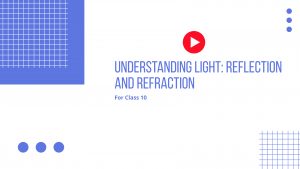NCERT Solutions for Science Class 10 Chapter 11
NCERT Solutions for class-10 Science chapter 11 “The Human Eye and the colorful world” is curated by senior and experienced teachers of EduAid. Before answering the questions of Chapter 11 , read the theory of the chapter multiple times and get a clear understanding of the concepts included in the chapter.
Here are the answers of the questions included in the NCERT book. Before diving deep into the answers, try to attempt the questions by yourself.
1. What is meant by power of accommodation of eye?
Solution : When the ciliary muscles are relaxed, the eye lens becomes thin, the focal length increases, and the distant objects are clearly visible to the eyes. To see the nearby objects clearly, the ciliary muscles contract making the eye lens thicker. Thus, the focal length of the eye lens decreases and the nearby objects become visible to the eyes. Hence, the human eye lens is able to adjust its focal length to view both distant and nearby objects on the retina. This ability is called the power of accommodation of the eyes.
2. A person with a myopic eye cannot see objects beyond 1.2 m distinctly. What should be the corrective lens used to restore proper vision?
Solution :The person is able to see nearby objects clearly, but he is unable to see objects beyond 1.2 m. This happens because the image of an object beyond 1.2 m is formed in front of the retina and not at the retina, as shown in the given figure.

To correct this defect of vision, he must use a concave lens. The concave lens will bring the image back to the retina as shown in the given figure.

3. What is the far point and near point of the human eye with normal vision?
Solution : The near point of the eye is the minimum distance of the object from the eye, which can be seen distinctly without strain. For a normal human eye, this distance is 25 cm.
The far point of the eye is the maximum distance to which the eye can see the objects clearly. The far point of the normal human eye is infinity.
4. A student has difficulty reading the blackboard while sitting in the last row. What could be the defect the child is suffering from? How can it be corrected?
Solution : A student has difficulty in reading the blackboard while sitting in the last row. It shows that he is unable to see distant objects clearly. He is suffering from myopia. This defect can be corrected by using a concave lens.
5. The human eye can focus objects at different distances by adjusting the focal length of the eye lens. This is due to
(a) Presbyopia (b) Accommodation
(c) Near-sightedness (d) Far-sightedness
Solution :
(b) Human eye can change the focal length of the eye lens to see the objects situated at various distances from the eye. This is possible due to the power of accommodation of the eye lens.
6. The human eye forms the image of an object at its
(a) Cornea (b) Iris (c) Pupil (d) Retina
Solution : (d) Retina
7. The least distance of distinct vision for an eye lens is caused by the action of the
(a) 25 m (b) 2.5 cm (c) 25 cm (d) 2.5 m
Solution : (c) 25 cm
8. The change in focal length of an eye lens is caused by the action of the
(a) Pupil (b) Retina (c) Cilliary muscles (d) Iris
Solution : (c) Cilliary muscles
9. A person needs a lens of power \(-5.5\) dioptre for correcting his distinct vision. For correcting his near vision he needs a lens \(+1.5\) dioptre. What is the focal length of the lens required for correcting (i) distinct vision, and (ii) near vision?
Solution :
(i) Power of lens needed for correction distant vision of the person \((P) = -5.5\space D\)
Focal length of lens required for correcting distant vision (\(f\))
\(= \frac{1}{P} = \frac{1}{-5.5\space m} = 0.18\space m = 18\space cm\).
(ii) For correcting near vision the power of lens required \((P) = +1.5\space D\)
Focal length of lens required for correcting near vision (\(f\))
\(= \frac{1}{P} =\frac{ 1}{1.5\space m} = 0.67\space m = 66.7\space cm\).
10. The far point of a myopic person is \(80\space cm\) in front of the eye. What is the nature and power of the lens required to correct the problem?
Solution :
To correct the myopia the person concerned should use concave lens of focal length \((f) = -80\space cm = -0.80\space m\)
Power of lens \((P) = \frac{1}{f(m)} = \frac{1}{-0.80} =\frac{ 100}{-80} = -1.25\space D\).
11. Make a diagram to show how hypermetropia is corrected. The near point of a hypermetropic eye is \(1\space m\). What is the power of the lens required to correct this defect? Assume that near point of the normal eye is \(25\space cm\).
Solution : Diagram representing the correction of hypermetropia is a follows:

Near point of defective eye is 1 m and that of normal eye is \(25\space cm\).
Here, \(u = -25\space cm,\space v = -1m = 100\space cm\).
Using lens formula
\(\frac{1}{f} =\frac{ 1}{v} – \frac{1}{u}\)
\(\frac{1}{f} =\frac{ 1}{-100} + \frac{1}{25} =\frac{ 3}{100}\)
\(f =\frac{ 100}{3\space cm} = \frac{1}{3\space m}\)
\(P = \frac{1}{f(m)} =\frac{ 1}{0.33} = +3.0\space D\).
12. Why is a normal eye not able to see clearly the objects placed closer than \(25\space cm\)?
Solution : Due to limit of power of accommodation, the focal length of the eye lens cannot be decreased below certain minimum limit. So, a normal eye cannot see clearly the objects placed closer than minimum distance, called near point of the eye.
13. What happen to the image distance in the eye when we increase the distance of an object from the eye?
Solution : The image is formed on the retina even on increasing the distance of an object from the eye. In fact, the eye lens becomes thinner and its focal length increases as the object is moved away from the eye and consequently image is formed on the retina.
14. Why do stars twinkle?
Solution : Stars twinkle due to atmospheric refraction of starlight. As the stars are very away they behave as almost point sources of light. As on account of atmospheric refraction, the path of rays of light coming from the star goes on varying slightly, the apparent position of the star fluctuates and the amount of light entering the eye flickers, so sometimes the star appear brighter and at some other time, fainter. Thus the stars twinkle.
15. Explain why the planets do not twinkle.
Solution : Planets are much closer to the earth and are seen as extended source. So, a planet may be considered as a collection of a large number of point-sized light sources. Although light coming from individual point-sized sources flickers but the total amount of light entering our eye from all the individual point-sized sources average out to be constant. Thereby, planets appear equally brighter and there is no twinkling of planets.
16. Why does the Sun appear reddish early in the morning?
Solution : During sunrise, the light rays coming from the Sun have to travel a greater distance in the earth’s atmosphere before reaching our eyes. In this journey, the shorter wavelengths of lights are scattered out and only longer wavelengths are able to reach our eyes. Since blue colour has a shorter wavelength and red colour has a longer wavelength, the red colour is able to reach our eyes after the atmospheric scattering of light. Therefore, the Sun appears reddish early in the morning.
17. Why does the sky appear dark instead of blue to astronaut?
Solution : Blue colour of the sky is on account of scattering of light of shorter wavelength by particles in the atmosphere of earth. If the earth had no atmosphere, there would not have been any scattering and sky would have looked dark. When astronaut in his spacecraft goes above the atmosphere of earth, sky appears dark to him because there is no scattering of light.
Study materials
- Refernce Books
- NCERT Solutions
- Syllabus







